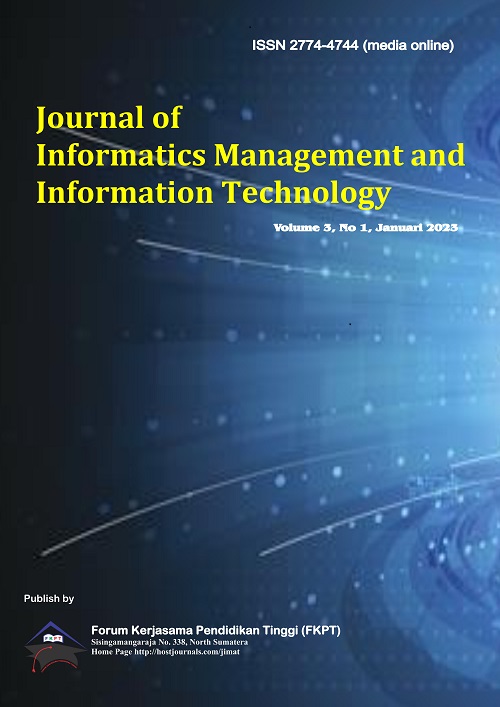Penerapan Metode Additive Ratio Assement (ARAS) dalam Pemilihan Customer Service Terbaik
DOI:
https://doi.org/10.47065/jimat.v3i1.239Keywords:
DSS; Selection of Customer Service; Additive Ratio Assessment; ARAS methodAbstract
There are several references or assessments in determining the best customer service, including those based on customer service performance assessments, namely Cross Selling, Greeting Service Recovery, Grooming, and Discipline. In this study the authors used the ARAS method in selecting the best Customer Service. Use the Additive Ratio Assessment (ARAS) method where each criterion is compared to produce the best. The results of the study provide alternative A3 which is the alternative chosen to be the best alternative with a value of 0.2207.
Downloads
References
D. Nofriansyah and S. Defit, Multi Criteria Decision Making (MCDM) pada Sistem Pendukung Keputusan. 2018.
D. Nofriansyah, Konsep Data Mining Vs Sistem Pendukung Keputusan. 2015.
T. Limbong et al., Sistem Pendukung Keputusan: Metode & Implementasi. Medan: Yayasan Kita Menulis, 2020.
Efraim Turban and Jay E. Aronson, Decision Support System and Intelligent Systems. 2001.
S. Dharma Hardi et al., “Implementation of Computer Based Systems for Effective Deci-sions in Acceptance of Vikar,” Int. J. Eng. Technol., vol. 7, no. 3, pp. 101–104, 2018.
R. Addenan and W. Susanti, “Penerapan Metode Rank Order Centroid dan Additive Ratio Assessment Pada Aplikasi Rekomendasi Supplier,” Edumatic J. Pendidik. Inform., vol. 5, no. 1, pp. 31–40, 2021.
Nindian Puspa Dewi, Ubaidi, and Elsi Maharani, “Sistem Pendukung Keputusan Pemilihan Sales Terbaik Menggunakan Metode Rank Order Centroid (ROC) dan Additive Ratio Assessment (ARAS) Berbasis Web,” Digit. Zo. J. Teknol. Inf. dan Komun., vol. 12, no. 2, pp. 172–183, 2021.
F. Pratiwi, F. T. Waruwu, D. P. Utomo, and R. Syahputra, “Penerapan Metode ARAS Dalam Pemilihan Asisten Perkebunan Terbaik Pada PTPN V,” in Seminar Nasional Teknologi Komputer & Sains (SAINTEKS), 2019.
R. Kharisman Ndruru, “Penerapan Metode Additive Ratio Assessment (ARAS) dan Rank Order Centroid (ROC) Dalam Pemilihan Jaksa Terbaik Pada Kejaksaan Negeri Medan,” Semin. Nas. Teknol. Komput. Sains, pp. 367–372, 2020.
N. A. H. Lia Ciky Lumban Gaol, “SISTEM PENDUKUNG KEPUTUSAN PEMILIHAN TEAM LEADER SHIFT TERBAIK DENGAN MENGGUNAKAN METODE ARAS STUDI KASUS PT. ANUGRAH BUSANA INDAH Lia,” Inf. dan Teknol. Ilm., 2018.
L. Handayani, M. Syahrizal, and K. Tampubolon, “Pemilihan Kepling Teladan Menerapkan Metode Rank Order Centroid (Roc) Dan Metode Additive Ratio Assessment (Aras) Di Kecamatan Medan Area,” KOMIK (Konferensi Nas. Teknol. Inf. dan Komputer), vol. 3, no. 1, pp. 532–538, 2019.
H. Syahputra, M. Syahrizal, S. Suginam, S. D. Nasution, and B. Purba, “SPK Pemilihan Konten Youtube Layak Tonton Untuk Anak-Anak Menerapkan Metode Additive Ratio Assessment (ARAS),” Semin. Nas. Teknol. Komput. Sains, vol. 1, no. 1, pp. 678–685, 2019.
J. Hutagalung and M. T. Indah R, “Pemilihan Dosen Penguji Skripsi Menggunakan Metode ARAS, COPRAS dan WASPAS,” J. Sisfokom (Sistem Inf. dan Komputer), vol. 10, no. 3, pp. 354–367, 2021.
Bila bermanfaat silahkan share artikel ini
Berikan Komentar Anda terhadap artikel Penerapan Metode Additive Ratio Assement (ARAS) dalam Pemilihan Customer Service Terbaik
ARTICLE HISTORY
Issue
Section
Copyright (c) 2023 Sri Agustiani Br Siburian, Mohammad Taufan Asri Zaen, Setiawansyah, Dodi Siregar, Erlin Windia Ambarsari, Yuwan Jumaryadi

This work is licensed under a Creative Commons Attribution 4.0 International License.
Authors who publish with this journal agree to the following terms:
- Authors retain copyright and grant the journal right of first publication with the work simultaneously licensed under Creative Commons Attribution 4.0 International License that allows others to share the work with an acknowledgment of the work's authorship and initial publication in this journal.
- Authors are able to enter into separate, additional contractual arrangements for the non-exclusive distribution of the journal's published version of the work (e.g., post it to an institutional repository or publish it in a book), with an acknowledgment of its initial publication in this journal.
- Authors are permitted and encouraged to post their work online (e.g., in institutional repositories or on their website) prior to and during the submission process, as it can lead to productive exchanges, as well as earlier and greater citation of published work (Refer to The Effect of Open Access).















